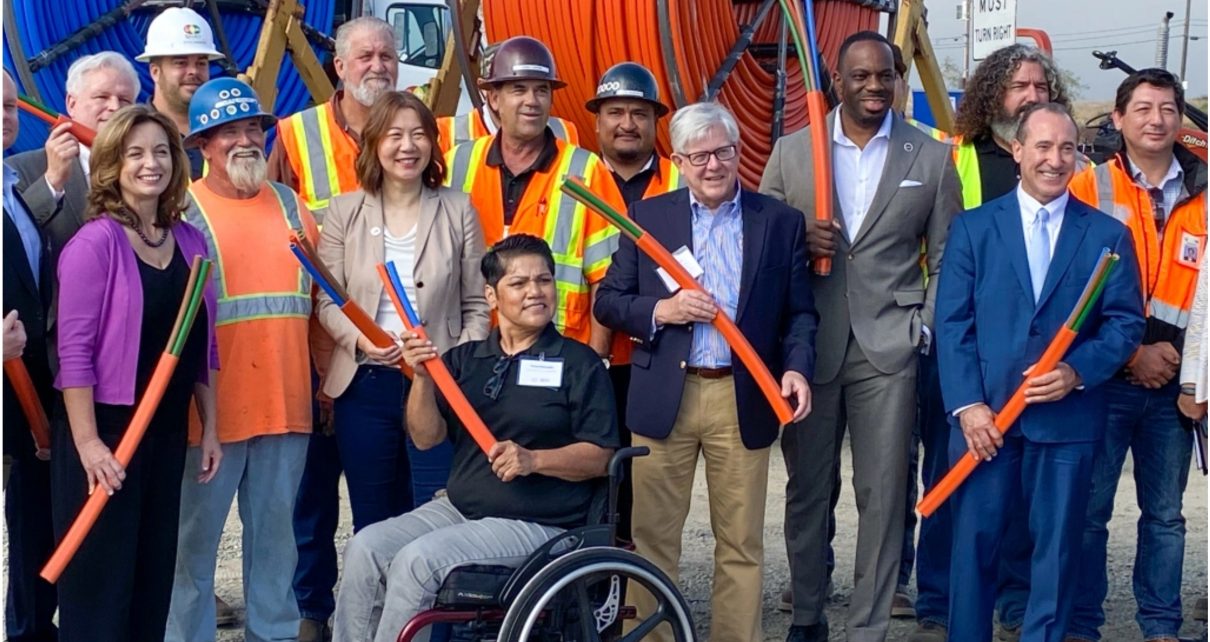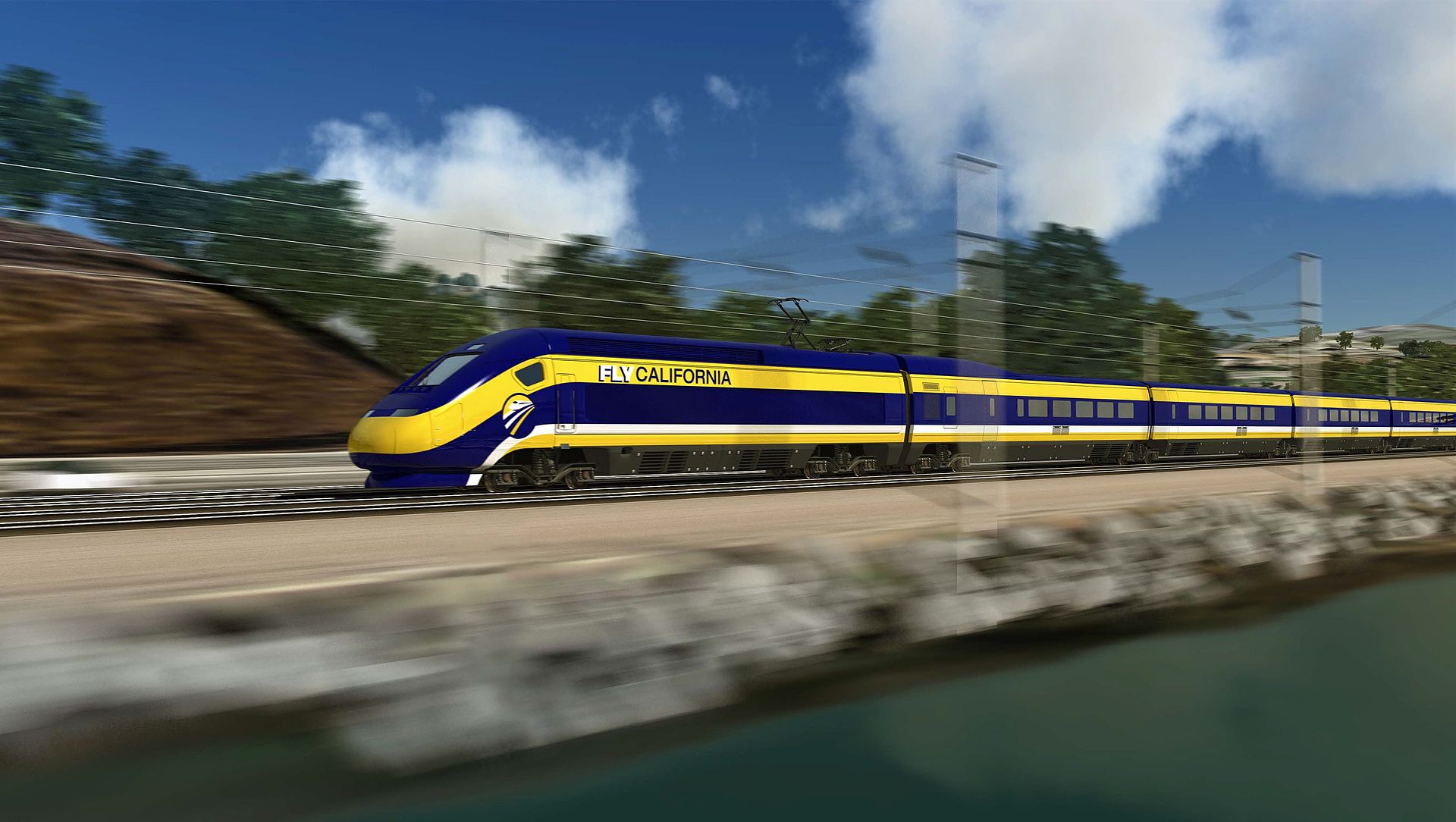
Newsom administration officials and construction executives at the High-Speed Groundbreaking in San Diego on 10/14/2022 (Photo: gov.ca.gov)
State Begins Construction On $6.5 Billion, 10,000 Mile Broadband Internet Network Across California
Network is expected to be completed
By Evan Symon, October 15, 2022 2:30 am
Newsom administration officials and construction executives laid a groundbreaking ceremony in San Diego on Friday, kicking off the start of a massive $6.5 billion, 10,000 mile broadband internet network designed to give high-speed internet to unserved and underserved areas of the state.
While there were proposals for high-speed internet to reach those locations dating back to over a decade, a renewed push in 2020 and 2021 brought forth a more concerted effort. Specifically, Senate Bill 156, which would set up, construct, and fund the program, was brought before the Assembly and Senate last year. While Republican lawmakers held some reservations about the program over its need and cost, changes to the bill and expanding high-speed internet into more rural areas of the state won them over, with it eventually passing the Senate 39-0 and the Assembly 78-0 last year. In July of 2021, Governor Newsom then signed the bill into law.
“As we work to build California back stronger than before, the state is committed to addressing the challenges laid bare by the pandemic, including the digital divide holding back too many communities in a state renowned for its pioneering technology and innovation economy,” said Newsom at the bill signing last year. “This $6 billion investment will make broadband more accessible than ever before, expanding opportunity across the spectrum for students, families and businesses – from enhanced educational supports to job opportunities to health care and other essential services. I thank the Legislature for its partnership on this critically important step to ensuring that California’s economic recovery will leave no part of our state behind.”
According to the now-signed law, $3.25 billion is to go to to build, operate and maintain an open access, state-owned middle mile high-speed internet network, $2 billion to set up last-mile broadband connections that will connect homes and businesses with local networks, and $750 million is for a loan loss reserve fund to bolster the ability of local governments and nonprofits to secure financing for broadband infrastructure. SB 156 also set up a broadband czar position within the California Department of Technology, and a broadband advisory committee, to help work out the project.
The project, known as Broadband for All, spent the last year in planning before the groundbreaking on Friday. San Diego was ultimately chosen as the starting point due to it having many underserved communities and it being on the far end of the state.
In a statement, Newsom added “California is now one step closer to making the digital divide a thing of the past. We’re starting construction today to get affordable high-speed internet in every California home because livelihoods depend on equitable access to a reliable and fast internet connection. This is about ensuring that all Californians, no matter the zip code they call home, can be part of the Golden State’s thriving and diverse economy.”
While the groundbreaking, which added a total of 500 feet on Friday, was celebrated by many, others continued to be skeptical towards the project.
“A lot of people are hoping that this won’t be another boondoggle,” said Elise Sims, a community organizer who helps low-income Californians get internet access, to the Globe on Friday. “It’s good to bring the internet to everyone, but there are some real questions going into this. A lot of people are concerned that the $6.5 billion tag won’t go up even more. We all saw how much the high-speed rail program shot up in the past few decades. Who knows how many unexpected costs will come here? We already added $550 million to it earlier this year after all.”
“Also, a lot of people have been pushing more to wi-fi and other sources, so the state doing this even as technology improves, it may cause problems. Overall, it’s a lot to sink money into, and it will take some time to see if it is really worth it.”
The construction of the network is expected to take place throughout much of the 2020’s.
- Bill to Require Law Enforcement Disclosure if AI Was Used To Help Write Reports - August 7, 2025
- Gov. Newsom Files FOIA Request To ‘Expose True Cost’ Of L.A. Federal Troop Deployment for Anti-ICE Riots - August 6, 2025
- California Redistricting: How Newsom’s Plan Will Demolish Hard Fought GOP Gains - August 6, 2025





Only $6.5 billion? Ha! We shall see. I think the private sector could do this more efficiently and economically. But just leave it to the government, they will screw this up big time.
No kidding, John.
“Internet to Nowhere” —— but just like the high speed rail debacle, it’ll cost ya!
I didn’t realize that San Diego was unserved and underserved in regard to high speed internet. A groundbreaking is typically done where construction is to begin. “…a groundbreaking ceremony in San Diego on Friday…” The way Kalifornia is, I would have bet the high speed internet would follow the same route as the high speed rail.
Deja Vu all over again.
So, we can spend $6.5 Billion on High Speed Broadband, and it’s easy and the legislature just passed it, but when we spend $9.0 Billion on High Speed rail everyone has a tizzy.
Thomas. You are off by more than a factor of 10 on the choo choo from nowhere to nowhere. What makes you think the HSB will be any different? This is all about the graft.
I would bet this ends up costing $50 billion, and the Newsom family will get richer in the process, Paul Pelosi is probably already buying shares in the companies offered the contracts. And to the previous comment $9 billion on the rail would still have been a waste, unfortunately that is the cost for about 50 miles of train when all the figures are done.
Be very concerned about this word salad cover for more centralized control, here folks…
This is more of Newsom’s “World Economic Forum” Build Back Better, central ownership and communist system deployment…
Let’s look at his words through that lens of perception :
“As we work to build California back stronger than before, the state is committed to addressing the challenges laid bare by the pandemic, including the digital divide holding back too many communities in a state renowned for its pioneering technology and innovation economy,”
Build California back stronger than before? WHO BROKE IT, Newsom??? You and your WEF flunkies at the CDC, WHO and FDA, for your plandemic!!!
Things were running better in early 2020 before the Communist Democrat takeover via “two weeks to flatten the curve” which led to cheat-by-mail voting season, early voting and tracking by Democrat operatives, “2000 Mules” and pResident Brandon…
Now we have a broken energy policy, rampant runaway inflation and another broken midterm election, with Ronna The RINO encouraging conservatives to “vote early by mail” so the Democrats know where to stuff the ballot boxes during election SEASON, instead of election DAY…
WHAT “digital divide”??? High speed internet is already privately available to anyone who wants it…
But it ain’t centrally provided and centrally controlled, like you and your Communist Democrat Party want it…
“According to the now-signed law, $3.25 billion is to go to to build, operate and maintain an open access, STATE-OWNED middle mile high-speed internet network, $2 billion to set up last-mile broadband connections that will connect homes and businesses with local networks, and $750 million is for a loan loss reserve fund to bolster the ability of local governments and nonprofits to secure financing for broadband infrastructure. SB 156 also set up a broadband czar position within the California Department of Technology, and a broadband advisory committee, to help work out the project.
The project, known as Broadband for All, …”
State-owned, state-ruled, state-controlled internet… just like Communist China, where Chairman Xi and his Ministry of Truth ruthlessly censor dissent via their STATE-OWNED, state-ruled, state-controlled and MONITORED internet…
DON’T FALL FOR THE FREE STUFF FOR ALL internet marketing pitch – it’s all for central digital surveillance and monitoring by the state…
Gmail used the same pitch and rollout and now it’s used to monitor and silence dissent…
Prove me wrong…
I will believe it when I see it. My mother lives just 15 miles from downtown Sacramento in the Gold Country foothills and there still isn’t any wired broadband access to her home available from any ISP. All she can get is either cellular data (which is expensive and limited) or fixed wireless (which is also expensive and limited). But something tells me the state doesn’t consider her “underserved”.